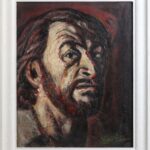
Volosačius Olegas
Oleg Volosačius was born in 1941 in Vitebsk, in a family of civil servants. His father died in the war, he practically did not know him. His mother worked in Lithuania. In 1945, he and his mother ended up in Marcinkonys, and from 1946 he settled in Vilnius, Žvėrynas, where he lived his whole life. He studied art at the Pioneer Palace (the palace was located at the foot of Gediminas Hill), with the painter Vincas Norkas, with whom he had friendly relations. Although he studied poorly at school, Oleg was successful in drawing, he even won an all-Union prize – a trip to Artek (an elite pioneer camp on the Black Sea). He was closely associated with artists A. Savickas, V. Dombrovskis, T. K. Valaitis, Š. Šimulynas and others. Although Oleg did not graduate from formal art studies, he lived his whole life only from art and painting. He was highly regarded by his fellow painters, recognized professionals. He was a true living legend of Žvėrynas – he is called the Van Gogh of Žvėrynas. Like the famous Vincent Van Gogh, he died alone and in poverty.
In his pictorial language, Oleg is nevertheless closer to Edvard Munch than to Vincent Van Gogh. His color combinations are sometimes gently fauvist, but much more often painfully expressionist. It would not be surprising, even likely, to meet Munch’s figure of “The Scream” in Oleg’s works. At the same time, he is characterized by what is called “real painting” – when paint is applied with pleasure, and the stroke comes out gestural, sensual. Oleg is a natural colorist who had an absolute color ear.
Oleg is a kind of descendant of the Grand Duchy of Lithuania: born in Vitebsk, spent his entire life in Vilnius, in Žvėrynas – in the lands of the most influential Radziwill family of the Grand Duchy of Lithuania. If he had been born at least a couple of decades earlier, his life trajectory would probably have reached Paris, where he would have felt very comfortable in the company of his fellow countrymen Chaim Soutine, Marc Chagall, Michel Kikoine, Pinchus Krémègne, because in terms of style, Oleg’s works are very close to the style of the authors of the École de Paris. However, fate destined him to become – perhaps somewhat sacrilegiously? – an iconic figure of Žvėrynas.
Oleg’s unconditional loyalty to painting and authentic creativity, his uncompromising position as an artist allow us to name Oleg Volosačius as an important Lithuanian creator of the last third of the 20th century, an artist-nugget who painted because he could not help painting.
Simona Makselienė
June 2015


